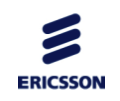
After more than 40 years of operation, DTVE is closing its doors and our website will no longer be updated daily. Thank you for all of your support.
Ericsson launches LTE broadcast platform
 Technology giant Ericsson is launching a new LTE broadcast platform to address demand for TV Everywhere services.
Technology giant Ericsson is launching a new LTE broadcast platform to address demand for TV Everywhere services.
Verizon Wireless in the US is to introduce LTE Broadcast for entertainment and sporting events beginning in 2014, while Australian mobile network operator Telstra to commence trials on its live network in 2013.
Alexander Sem, director, portfolio marketing, TV & Media at Ericsson, told DTVE that that the technology provider aimed to enable broadcast capability in LTE networks, adding it on top of data capability. The eMBMS multicast standard, HEVC encoding for compression, and MPEG DASH adaptive bit-rate encoding are the three key technologies in the Ericsson offer.
Ericsson has previously announced a partnership with Qualcomm to demonstrate devices that could support LTE broadcast. It has also announced the development of an HEVC platform for mobile TV applications. “We believe the first application that will benefit from the new compression is mobile,” said Sem.
Sem said size and quality of mobile screens had increased significantly recently, while tablets had emerged as he perfect device for video consumption. The increase in consumer demand to watch video on portable devices had also emerged as a significant phenomenon, he said. Data traffic was meanwhile expected to increase 12 times by 2018. There was therefore definitely a need to solve the bandwidth issue for video, said Sem.
Sem said that Ericsson LTE Broadcast would allow new revenue models to develop and allow service providers to use the available LTE spectrum. The technology requires an overlay on an existing LTE network through a software upgrade. If 10 or more users request the same video or other data, the service can switch dynamically to broadcast mode.
The company will demonstrate use cases at Mobile World Congress this week. One clear application is the broadcast of live events such as sports and news, said Sem. “You could also have venue specific services with multiple camera angles and an overlay of additional information. Popular media could be pushed to handsets, including popular TV shows, big live events or popular music videos. Finally, content [and software] could be pushed to be locally stored in the device, including for example the latest OS,” said Sem. He said that data network traffic typically peaks when new updates are available, so this technology could be used to offload some of that traffic. It could also be used for podcasts, he said.
Ericsson is working with Qualcomm to make sure that next generation devices will be able to receive the broadcast signal.
“You need to make sure that the battery is not drained and devices are utilised in a way that maintains acceptable battery life,” said Sem. “We want to make sure the ecosystem is in place.”
eMBMS, which has recently been standardised, has evolved to make sure all the different dynamics of multicast versus broadcast are managed. “You do not want to build a network that’s built only for broadcast. It can dynamically switch which is part of the standard but it’s up to each vendor to implement that. Ericsson’s video and mobile heritage has enabled it do this efficiently,” said Sem.
Ericsson has already released its first version of the recently ratified HEVC compression standard.
Sem said he expected the first commercial implementation of the technology to occur in the first quarter of 2014.


